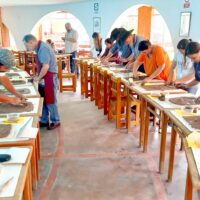How did anthroposophists live during the years of the German Democratic Republic (1949-1989)? Could they work at all? For security reasons, almost nothing was recorded. German geologist Dankmar Bosse reports on this time and documents everything in retrospect so that nothing is forgotten.
«Our field of work was inner work,»1 says the author of this fascinating book. Since anthroposophy was neither permitted nor forbidden, it operated in a grey area. It wasn’t until 1990 that the Anthroposophical Society was founded in Eastern Germany. Until then, the Christian Community, through consultation with the pastors, often provided a secret space where the work could happen.
Bosse looks at the anthroposophical work in twelve cities of the GDR. In Weimar, for example, Jo Voss (pastor of the Christian Community) who was active there from 1951, introduced young people to anthroposophy and even led study groups for students. Apart from that, there were also several small groups in the city. Up until 1975, older people would meet at Walter and Irmgard Bosse’s place. Here, ‹Western› guests often gave lectures, and class lessons were also held. From 1975, Ingrid Hüther started a Waldorf education group in her private home to prepare for a future Waldorf school. Unimaginable at that time! There were also lectures, lessons, and art courses for adults and children. After the fall of the Berlin Wall, the first Waldorf School in Thuringia was opened in Weimar in 1990!
Rudolf Steiner’s former colleague Anna Samweber, who later lived in East Berlin, led a working group there, and some small groups worked independently of each other. From 1972, the working group of Dankmar and Brigitte Bosse was included. After the fall of the Berlin Wall, a second circle was created, which was able to work until 2021.
The Christian Community began its work in West Berlin in 1945, and as of 1949, simple spaces could also be found in East Berlin. Later, the first floor of Schwedter Street, 263, became a cramped home for the community – the hall however could accommodate up to 100 people. The priests Karl-Hans Heinrich and Klaus Brüggemann and the priestess Gertrud Osterwald worked here. After the fall of the Berlin Wall, the community had to give up the space and was finally able to build a new church at Schwedter Street, 4. In addition to describing the difficult living conditions in the GDR, Bosse describes his own development, which drew his attention to geology early on. Due to special circumstances, he would have had the opportunity to stay in the West after August 13, 1961. However, Bosse chose the GDR because he anticipated his future field of work there, studied geology, and was a research assistant at the Central Geological Institute in Berlin until 1989. In the Christian Community, he became active in anthroposophy, and he had contact with physicist Bodo Hamprecht in West Berlin, who often arranged lectures. It wasn’t easy to get books by Steiner at that time, and friends tried to bring books from West Berlin. Bosse owned a repro device and secretly photographed books.
Community life in East Berlin was vibrant, especially in the 1980s through the ‹Werkstatt für sakrale Kunst› [Workshop for Sacred Art] – a very elastic term! As a ‹Novalis work›, it even included seminars for an introduction to anthroposophy. The three additional reports concern anthroposophical work in countries of the Eastern Bloc: with exciting illegal journeys within the Soviet Union and commemorating the unprecedented life of the priest Josef Adamec in Prague. The situation of anthroposophic medicine in the GDR is described based on the work of Irmgard Bosse, and the third report describes the fall of the Berlin Wall. Bosse analyses the events of November 9, 1989, in an exciting way, and the final report by Tobias P. captures the mood of the night.

This book is a careful and readable account in which the excitement of this time of upheaval can be felt, and lots of facts and experiences are tamed within a few pages. Added to this is the pleasant layout. The flow of the text is easy to follow despite the many long quotations, and only occasionally does one have to look up the context. The book is also intended to be a document for future readers, Bosse emphasizes.
The Stasi punished forbidden political connections and wasn’t interested in the intellectual content of anthroposophy. However, there was «an ideal inner disposition» for anthroposophy at that time. And especially around the ‹Werkstatt für sakrale Kunst› [Workshop for Sacred Art]: it «has changed the […] fate of many hundreds of people decisively towards the spirit.» With the reunification, the financial yardstick became decisive instead of the ideological one. Bosse’s conclusion: «Let us now prepare together for the next turning point! May then neither the comrade nor the customer, but the person who acts on his own initiative become king!»
Book Dankmar Bosse: Anthroposophie im Osten Deutschlands zu DDR-Zeiten. Edition Immanente, Berlin 2022.
Translation Monika Werner





